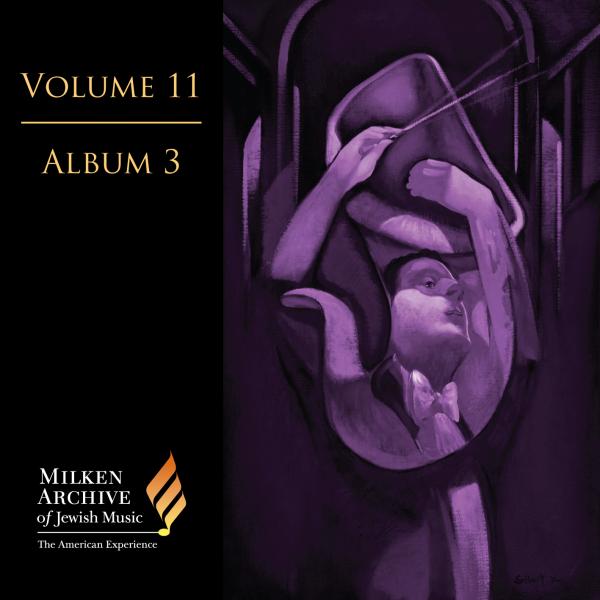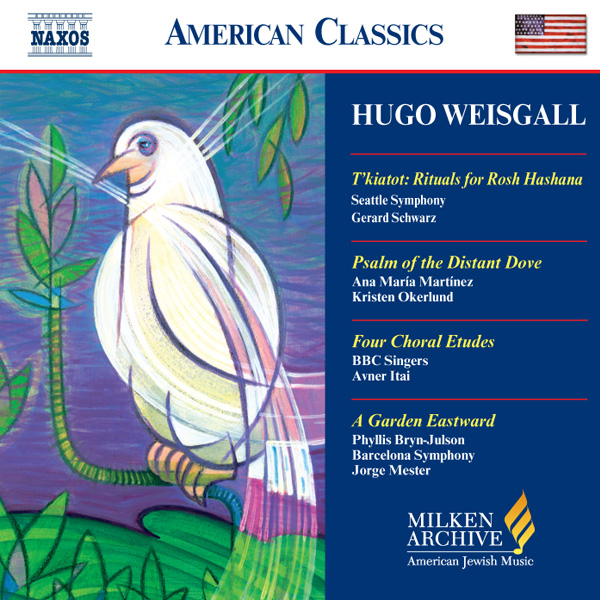Tracks
Liner Notes
Composed in 1985, T’kiatot: Rituals for Rosh Hashana, one of Weisgall’s few purely orchestral compositions, was given its premiere in New York City the following year. The work was commissioned by the 92nd Street YMHA, an important New York cultural institution that sponsored the Y Chamber Symphony. For more than ten years, beginning in 1977, that orchestra, conducted by Gerard Schwarz, its founder, premiered a number of new works, including this one, which Weisgall dedicated to the memory of his parents.
T’kiatot is not, however, absolute music. And for all its purely instrumental makeup, it may be one of Weisgall’s most manifestly Jewish pieces on a religious plane. The Judaic aspect does not apply so much to the overall sonority or style, which conform rigorously to the abstract, atonal affinities Weisgall shared with Schoenberg, Berg, and Webern—his musical and aesthetic models from the so-called Second Viennese School. Rather, its Judaic connection derives from its framing structural idea, which is based on a major section of the Rosh Hashana liturgy; from its integral absorption of a canonized Ashkenazi Rosh Hashana synagogue tune of medieval origin into the very fabric of the musical flow; and from its introduction of the ancient Temple-era instrument, the shofar, which, though used in antiquity for a variety of both religious and secular (including military) occasions, is today most emblematic of the High Holy Days. The shofar functions in T’kiatot as a “placing” and punctuating element, sonically as well as motivically.
The title, T’kiatot, refers to a central tripartite section of the Rosh Hashana musaf liturgy, which this music expresses and interprets instrumentally according to its evocations for the composer. (T’ki’atot is the presumed plural of the Aramaic t’ki’ata, the term signifying each of those three parts.) Musaf (lit., additional service) is the required service appended to the morning service on Sabbaths, Festivals, and High Holy Days, originating from—and reflecting—the “additional sacrifice” required in antiquity after the morning sacrificial ritual in the Temple in Jerusalem on those occasions (i.e., in addition to the usual weekday service). The term musaf, however, can be misleading, since it is not optional or “extra” in that sense. For all practical purposes, it amounts to an integral extension of those morning services. Especially on the High Holy Days, the musaf contains many poetic and dramatic texts that are unique to it. Over the centuries, the Rosh Hashana musaf liturgy in the Ashkenazi rite has acquired a rich musical tradition specific to it—a number of melodies as well as particular modal formulas and constructions (the nusaḥ hat’filla) that apply exclusively to that service. Moreover, the musaf for Rosh Hashana (as for Yom Kippur and the Three Festivals) contains some of the canonized seasonal leitmotifs known as missinai tunes, which date to the Middle Ages and are universal throughout Ashkenazi practice. The one for the t’ki’atot section, for the introductory text—aleinu l’shabbe’aḥ la’adon hakol (We adore the Lord of all...)—serves as a binding element in this orchestral work. It is believed to date at least to the 12th century.
The t’ki’atot section of the liturgy comprises three divisions: malkhuyyot (Divine sovereignty); zikhronot (remembrance); and shofarot (trumpet-like or shofar sounds heralding Divine revelation and fulfillment of the Divine promise for ultimate messianic redemption and liberation). Each division concerns and illustrates one of the three central theological themes of Rosh Hashana: 1) God’s absolute Kingship of the universe (malkhuyyot) and the ramifications of that supreme authority, in connection with which Rosh Hashana is also known as yom hadin—the Day of Judgment; 2) God as the Divine recorder of all acts and deeds (zikhronot), who therefore remembers all promises and covenants, in connection with which Rosh Hashana is known as yom hazikaron—the Day of Remembrance; and 3) God as the Revealer of Himself—through His Teaching, the Torah, and ultimately through Israel’s redemption from exile and its return to Zion, as well as the redemption of all humanity. In this connection Rosh Hashana is known by yet a third name: yom t’ru’a—the Day of the Shofar Blasts, which heralded God’s revelation on Mount Sinai when the Torah was given to the people through Moses, and which will also herald the ultimate redemption.
In modern contexts these three themes can translate to God as the primeval source of all existence itself—i.e., God as Creator of the universe and everything in it, and of nature itself; God in terms of history, and in Israel’s collective memory; and God the ultimate Revealer of truth and wisdom.
Each of these three liturgical divisions contains ten biblical quotations that pertain to and support its theme: three from the Torah followed by three from Psalms and then three from the Prophets, concluding with yet another from the Torah. This ritual and order is traceable at least to the 2nd century C.E., since it is mentioned in the Mishna (Rosh Hashana iv, 5–6), which dates to that period. At the conclusion of each division, the shofar is sounded according to a prescribed set of articulations, or “shofar blasts.” This practice, too, is cited in that same 2nd-century Mishna.
Each of the ten sets of biblical quotations is also preceded by a prologue and followed by a prayer and its related benediction. The insertion of these texts is attributed to the 3rd-century scholar Rav, who founded the Sura academy in Babylonia.
The great medieval sage and scholar Moses Maimonides interpreted the shofar blasts on Rosh Hashana (which also occur at other points in the service) as proclaiming: “You who are asleep, awaken! Search your deeds and repent! You who indulge all year in trifles, examine your souls and alter your ways. Let each one renounce his evil course.”
The composer provided the following notes in the program booklet at the premiere:
The [aleinu] melody begins with a descending major triad followed by an upward octave leap [continuing back downward—initially in stepwise motion]. I have used this motive in my first movement, which is an extended and generally slow fantasia. At the end of this movement, the shofar is sounded very far offstage.
The fantasia is characterized by majestic dotted rhythms; juxtapositions of the separate orchestral choirs, with special emphasis on the brass; and many statements of the triadic, diatonic synagogue motive [the missinai aleinu tune] by the solo French horn...accompanied by dissonant harmonies in the brass. Additional musical material includes elaborate, cantillation- like figuration and rapid repeated notes, recalling shofar calls. [These are notated in Weisgall’s preface to the score.]
The second movement is basically a scherzo, which brings an optimistic mood to the remembrance theme. The third and final movement is built largely on motifs that are based on the various prescribed shofar blasts, or “calls”:
They are sounded in turn first by all the brass instruments, and then by the woodwinds and the strings. In this movement, the shofar is made part of the orchestral fabric of the score, and is sounded, still offstage, but [this time] very close to the audience.
Weisgall presented the shofar calls here in a different order from the prescribed one, but as in the synagogue service, the movement concludes with the t’ki’a g’dola—the long, sustained shofar blast, while the orchestral music grows slower and softer.
Credits
Composer: Hugo WeisgallPerformers: Steven A. Ovitsky, Shofar; Gerard Schwarz, Conductor; Seattle Symphony
Publisher: Theodore Presser Co.

